![Gingerbreadman map for subset
Q
2
,
[
-
10..10
,
-
10..10
]
{\displaystyle Q^{2},[-10..10,-10..10]}
: the color of each point is related to the relative orbit period. To view the gingerbread man, you must rotate the image 135 degrees clockwise. GBM.png](http://upload.wikimedia.org/wikipedia/commons/thumb/f/f2/GBM.png/220px-GBM.png)
In dynamical systems theory, the Gingerbreadman map is a chaotic two-dimensional map. It is given by the piecewise linear transformation: [1]
![Gingerbreadman map for subset
Q
2
,
[
-
10..10
,
-
10..10
]
{\displaystyle Q^{2},[-10..10,-10..10]}
: the color of each point is related to the relative orbit period. To view the gingerbread man, you must rotate the image 135 degrees clockwise. GBM.png](http://upload.wikimedia.org/wikipedia/commons/thumb/f/f2/GBM.png/220px-GBM.png)
In dynamical systems theory, the Gingerbreadman map is a chaotic two-dimensional map. It is given by the piecewise linear transformation: [1]
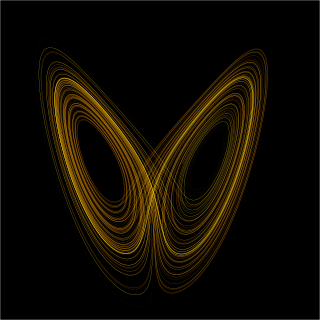
In chaos theory, the butterfly effect is the sensitive dependence on initial conditions in which a small change in one state of a deterministic nonlinear system can result in large differences in a later state.

Chaos theory is an interdisciplinary scientific theory and branch of mathematics focused on underlying patterns and deterministic laws, of dynamical systems, that are highly sensitive to initial conditions, that were once thought to have completely random states of disorder and irregularities. Chaos theory states that within the apparent randomness of chaotic complex systems, there are underlying patterns, interconnection, constant feedback loops, repetition, self-similarity, fractals, and self-organization. The butterfly effect, an underlying principle of chaos, describes how a small change in one state of a deterministic nonlinear system can result in large differences in a later state. A metaphor for this behavior is that a butterfly flapping its wings in Brazil can cause a tornado in Texas.

In mathematics, a dynamical system is a system in which a function describes the time dependence of a point in an ambient space. Examples include the mathematical models that describe the swinging of a clock pendulum, the flow of water in a pipe, the random motion of particles in the air, and the number of fish each springtime in a lake. The most general definition unifies several concepts in mathematics such as ordinary differential equations and ergodic theory by allowing different choices of the space and how time is measured. Time can be measured by integers, by real or complex numbers or can be a more general algebraic object, losing the memory of its physical origin, and the space may be a manifold or simply a set, without the need of a smooth space-time structure defined on it.
The logistic map is a polynomial mapping of degree 2, often cited as an archetypal example of how complex, chaotic behaviour can arise from very simple non-linear dynamical equations. The map was popularized in a 1976 paper by the biologist Robert May, in part as a discrete-time demographic model analogous to the logistic equation written down by Pierre François Verhulst. Mathematically, the logistic map is written

In mathematics, the Lyapunov exponent or Lyapunov characteristic exponent of a dynamical system is a quantity that characterizes the rate of separation of infinitesimally close trajectories. Quantitatively, two trajectories in phase space with initial separation vector diverge at a rate given by
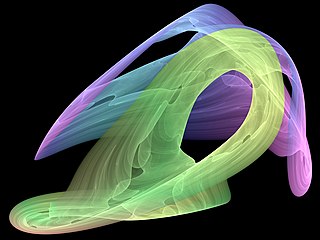
In the mathematical field of dynamical systems, an attractor is a set of states toward which a system tends to evolve, for a wide variety of starting conditions of the system. System values that get close enough to the attractor values remain close even if slightly disturbed.
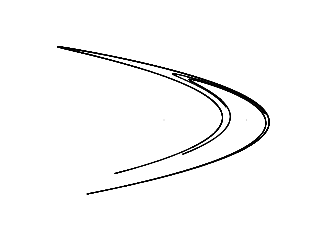
The Hénon map, sometimes called Hénon-Pomeau attractor/map, is a discrete-time dynamical system. It is one of the most studied examples of dynamical systems that exhibit chaotic behavior. The Hénon map takes a point (xn, yn) in the plane and maps it to a new point

The dyadic transformation is the mapping

The Rössler attractor is the attractor for the Rössler system, a system of three non-linear ordinary differential equations originally studied by Otto Rössler in the 1970s. These differential equations define a continuous-time dynamical system that exhibits chaotic dynamics associated with the fractal properties of the attractor.
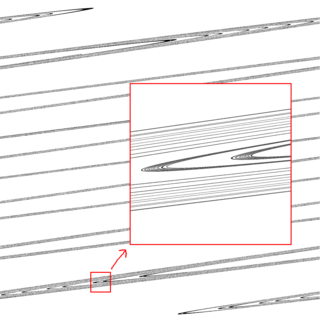
The Zaslavskii map is a discrete-time dynamical system introduced by George M. Zaslavsky. It is an example of a dynamical system that exhibits chaotic behavior. The Zaslavskii map takes a point in the plane and maps it to a new point:

The Duffing map is a discrete-time dynamical system. It is an example of a dynamical system that exhibits chaotic behavior. The Duffing map takes a point (xn, yn) in the plane and maps it to a new point given by

The Tinkerbell map is a discrete-time dynamical system given by:
In dynamical systems theory, a period-doubling bifurcation occurs when a slight change in a system's parameters causes a new periodic trajectory to emerge from an existing periodic trajectory—the new one having double the period of the original. With the doubled period, it takes twice as long for the numerical values visited by the system to repeat themselves.

The Lorenz system is a system of ordinary differential equations first studied by mathematician and meteorologist Edward Lorenz. It is notable for having chaotic solutions for certain parameter values and initial conditions. In particular, the Lorenz attractor is a set of chaotic solutions of the Lorenz system. In popular media the "butterfly effect" stems from the real-world implications of the Lorenz attractor, namely that in a chaotic physical system, in the absence of perfect knowledge of the initial conditions, our ability to predict its future course will always fail. This underscores that physical systems can be completely deterministic and yet still be inherently unpredictable. The shape of the Lorenz attractor itself, when plotted in phase space, may also be seen to resemble a butterfly.
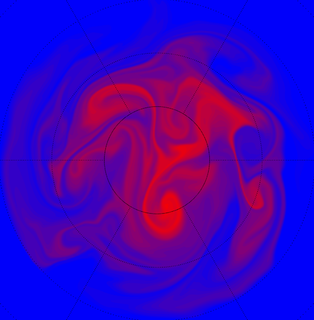
In chaos theory and fluid dynamics, chaotic mixing is a process by which flow tracers develop into complex fractals under the action of a fluid flow. The flow is characterized by an exponential growth of fluid filaments. Even very simple flows, such as the blinking vortex, or finitely resolved wind fields can generate exceptionally complex patterns from initially simple tracer fields.
Chaotic scattering is a branch of chaos theory dealing with scattering systems displaying a strong sensitivity to initial conditions. In a classical scattering system there will be one or more impact parameters, b, in which a particle is sent into the scatterer. This gives rise to one or more exit parameters, y, as the particle exits towards infinity. While the particle is traversing the system, there may also be a delay time, T—the time it takes for the particle to exit the system—in addition to the distance travelled, s, which in certain systems, i.e., "billiard-like" systems in which the particle undergoes lossless collisions with hard, fixed objects, the two will be equivalent—see below. In a chaotic scattering system, a minute change in the impact parameter, may give rise to a very large change in the exit parameters.

In the mathematics of dynamical systems, the double-scroll attractor is a strange attractor observed from a physical electronic chaotic circuit with a single nonlinear resistor. The double-scroll system is often described by a system of three nonlinear ordinary differential equations and a 3-segment piecewise-linear equation. This makes the system easily simulated numerically and easily manifested physically due to Chua's circuits' simple design.
In the fields of dynamical systems and control theory, a fractional-order system is a dynamical system that can be modeled by a fractional differential equation containing derivatives of non-integer order. Such systems are said to have fractional dynamics. Derivatives and integrals of fractional orders are used to describe objects that can be characterized by power-law nonlocality, power-law long-range dependence or fractal properties. Fractional-order systems are useful in studying the anomalous behavior of dynamical systems in physics, electrochemistry, biology, viscoelasticity and chaotic systems.
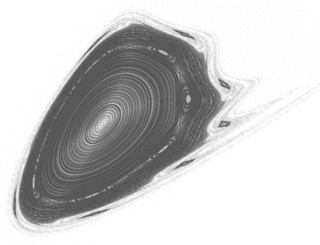
In dynamical systems theory, the Bogdanov map is a chaotic 2D map related to the Bogdanov–Takens bifurcation. It is given by the transformation: